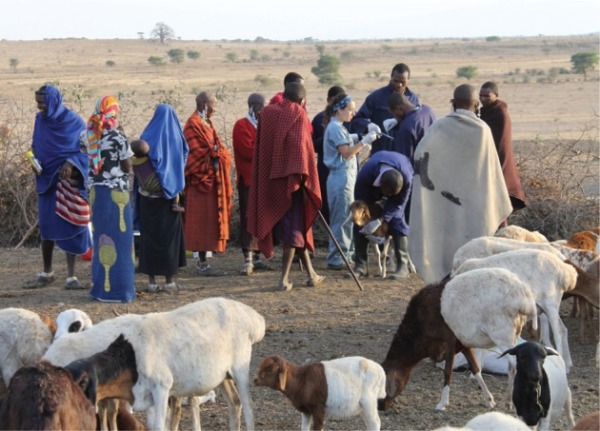
Study team visiting a pastoral community in Tanzania.
Kigali: Every year, nearly 60 000 people die from rabies, and other zoonotic diseases such as avian influenza, Ebola and Rift Valley fever. These diseases pose risks to both animals and people.
Given the complex human-animal-environment interface, collaboration through a One Health approach, cultivates both greater knowledge of the disease threat for experts as well as greater understanding of the needs within each sector to appropriately address the threat of disease.
To address the challenge of zonoose threats, a training workshop in Joint Risk Assessment (JRA) using the Tripartite Operational Tool, was organized for Rwandan experts from the Ministry of Health, the Ministry of Agriculture and Animal Resources, University of Rwanda, the Wildlife Unit of the Rwanda Development Board, and other key partners. The tool was jointly developed by the Food and Agriculture Organization of the United Nations (FAO), World Health Organization (WHO) and World Organisation for Animal Health (OIE).
The Tripartite operational tool for conducting Joint Risk Assessments (JRA) is developed for ministries and government agencies responsible for control and management of zoonosis and other relevant sectors to effectively control and manage zoonoses at the human-animal-environment interface.
The Joint Risk Assessment (JRA) is a rapid qualitative risk assessment used to address arising or existing health threats at the human-animal-environment interface. It is an iterative systematic approach, using currently available knowledge to provide decision makers with science/evidence-based risk management options and communication messages, aligned among sectors.
The JRA pilot workshop in Rwanda was organized from 30 July to 02 August 2019, with the funding from the United States Agency for International Development (USAID), under the project implemented by FAO titled “Provision of technical support for the One Health platform in Rwanda”.
Reinforcing One Health
As one of the primary goals of the Rwanda One Health platform is to promote and strengthen interdisciplinary collaboration and partnership, the JRA provides a practical tool contributing to achieve the One Health Strategic Plan (2019-2024).
Traore Tieble from WHO said “When done jointly and across the spectrum of different sectors, JRAs are more likely to be relevant and acceptable to all stakeholders, and therefore also more likely to be effective. They can be aligned across sectors for implementation by the different partners or can be jointly implemented.”
Charles Karangwa, acting Director-General of Food and Drugs Authority, recalled that with the looming climate change and its effects, One Health approach is no longer an option but the only way to deal with zoonotic diseases.
“Decreasing zoonotic disease risks requires first a good understanding of where and why risks exist. This understanding can be built through national level risk assessments. To fully understand and manage zoonotic disease threats, information and expertise from all the relevant sectors must be brought together and these risks should be assessed jointly,” Charles noted.
Routine JRA supports international regulations, such as International Health Regulations (IHR, 2005) and the OIE standards, by fostering intersectoral collaboration to identify missing information, and gaps where capacity can be usefully built and/or strengthen.
Future plans
The Joint Risk Assessment training was organized with the general purpose of building capacity of Rwanda’s Veterinary Services, public health services and Environment health practitioners to acquire the necessary skills to effectively undertake joint risk assessment.
The trained officers will form a pool of JRA experts in Rwanda that can be called upon to support piloting and/or implementation of the JRA tool in the country.
Contributing to SDGs
The collaborative approach used in Joint Risk Assessment is one of the fundamental principles to achieve the Sustainable Development Goals (SDGs) which in turn provide a unique opportunity for a move towards a more integrated approach (One Health) to the future health of all. (End)
